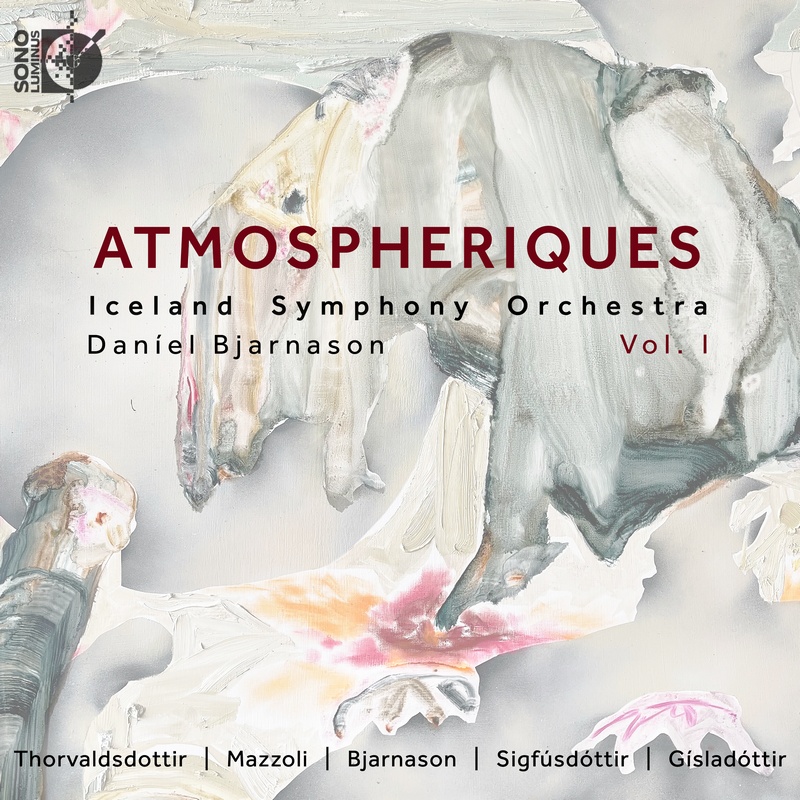Two years have passed since the Iceland Symphony Orchestra’s previous series of albums, Recurrence, Concurrence, Occurrence, and their latest release, Atmospheriques Vol. I, is the start of a new series. As before, the orchestra is conducted by Daníel Bjarnasson, and the emphasis is again on Icelandic composers, though here they’re joined by one outsider, suggesting this series may be including a wider geographical outlook.

The album’s primary weak spot is Clockworking, a piece by María Huld Markan Sigfúsdóttir originally composed for string trio and electronics but heard here in a reworking for full orchestra. The original, included on Nordic Affect’s 2015 album Clockworking, has a lightness that continually propels onward, the total effect sounding like a large-scale, electroacoustic music box. So it’s surprising to hear this new version sound so contrastingly sluggish, an impression reinforced by the decision to hold back the momentum until over two minutes in (in the original it starts very early on). Eventually it does sound similarly mechanistic, but the harmonic language is greatly simplified, with the result that the piece just sounds indistinguishable from any generic, minimalistic blah.
The other four compositions all demonstrate differing degrees of tension out of which clarity does or doesn’t arise. The simplest is US composer Missy Mazzoli‘s Sinfonia (for Orbiting Spheres), a work i explored previously following its performance at the 2017 Proms. Then i referred to its “shining vagueness”, but it’s interesting how, in this context, it comes across as the most direct music on the album. Its lyrical thread (initially redolent of James MacMillan in its grace note decoration), makes its way through a gently surging environment that periodically comes apart. Percussion tremolos, brass blazes and wind flourishes pop up on all sides, but the melody persists, at times confusingly giving the impression of moving simultaneously leisurely and at speed (an effect caused in part by a snare drum). Yet it’s the volatility of the piece that keeps it compelling, arriving rather unexpectedly in a place of pure ethereality.
Similarly volatile, though more problematic, is Anna Thorvaldsdottir‘s Catamorphosis. The piece brings to mind her earlier work Metacosmos in the way it occupies a soundworld laden with uncertainty, but out of which a strange, sad, melancholic music improbably emerges. That happens in Catamorphosis at around the same point as Metacosmos (around six minutes in), but the remainder of the piece is nowhere near so structurally clear. Once the sad music fizzles the piece seems to lack any certainty about where to go or what to do. A lengthy oscillating major-minor section is broken up with turbulence; one of her trademark drones then underpins a sequence that seems lyrical while worried by soft confusion at the fringes. The music comes to feel stuck, arbitrary, even a bit noodly, and ultimately lost and confused, continuing for the sake of continuing. Thorvaldsdottir’s music is always interesting, sometimes radical, but it’s hard to regard Catamorphosis as anything other than a rare misstep in her output. One could perhaps regard the material as the product of quasi-spontaneous activity in a relatively limited space / language, but that doesn’t really resolve these issues.
In some respects the most extreme of these works is ÓS by Bára Gísladóttir. When i first encountered the piece, at the 2020 Dark Music Days, i found it impossible to penetrate, a surface of familiar avant-garde gestures. But this performance teases it open, revealing a complex, almost unfathomable network of pitchless activity taking place at the cusp of our ability to resolve. Faint glistening whistles, distant tappings, friction noise; more and more of this bustling activity fills the space, becoming clangorous (though never resonant) and even rather unsettling when weird low growls materialise later on. Adding to this feeling is the abrupt way these textural formations are abruptly cancelled and reset, leaving the one point of certainty being the fact that ÓS is all about mass rather than individual activity. It’s another typically enigmatic bit of sonorism from Iceland’s most forward-looking composer.
The highlight of Atmospheriques Vol. I is From Space I Saw Earth by Daníel Bjarnasson. In some ways it’s like a pitched version of ÓS, inhabiting a similarly nebulous soundworld, established at the start in the most fascinating way, with faint, shimmery, sinewy stuff all at something of a distance. A low-key swelling suggests breathing as the piece develops, a deep regular presence is felt rather than heard, and there’s the flavour of a tritone in the way notes start to align. Yet as soon as the music starts to suggest anything ostensibly certain it’s already moving beyond and away. That swelling becomes one of the only consistent points of reference, together with the sense that, despite appearances, lyricism is what’s driving the piece. Eruptions happen but are not merely held in check but pulled right back to little more than light tracery, allowing messy but beautiful melodic strands to emerge, out of focus, as if (considering the album’s title) heard through a thick atmospheric haze. The conclusion is marvellous, entering a kind of inverted plateau, deep and extended, with an impression of peripheral clarity perhaps trying to resolve into a major chord. Nothing so obvious: From Space I Saw Earth first polarises – the strings seemingly trying to get as high as possible away from ominous deep surges – and then unexpectedly breaks out onto another plane, somewhere sublime, even celestial.
Released by Sono Luminus, Atmospheriques Vol. I is available on CD/Blu-Ray and download.
